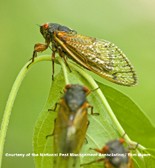Need assistance? Call 800.996.4402
Menu
Need assistance? Call 800.996.4402

Periodical cicadas are large insects often incorrectly referred to as locusts even though they are unrelated. They are known for the loud buzzing noise that males make to attract female mates.
There are at least 15 broods of periodical cicadas that emerge from underground in 13- or 17-year cycles in different parts of the country. In May 2013, a group of Brood II cicadas invaded the Northeastern United States from the Carolinas to Connecticut. Another brood of 17-year cicadas, Brood III, is expected to emerge in Iowa, Illinois and Missouri in 2014.
Immature periodical cicadas develop underground and feed on the juices of tree roots. After 13 or 17 years, they emerge from the soil when the temperature eight inches below the surface reaches 64 degrees. Once above ground, the periodical cicadas feed from a wide variety of deciduous plants and shrubs. They will remain above ground for about a month to reproduce, before laying their eggs on tree branches and dying. The cicada offspring fall to the ground and burrow in the soil until they re-emerge 13-17 years later.
It is not uncommon to find hundreds of thousands of periodical cicadas per acre; however, they are only considered nuisance pests and do not pose any health threats to humans.
Periodical cicadas can cause damage to young trees growing in the landscape. To prevent this, cover tree saplings with netting or cheesecloth. Netting should have a mesh of no less than 1/4 inch and should be placed over the trees when the first male songs are heard. The netting should be tied to the trunk beneath the lower branches and can be removed after adult cicada activity has ended.
The majority of a periodical cicada’s life is spent in an underground habitat. The area in which a brood is located must contain a large population of mature trees. Once above ground, the periodical cicadas climb onto nearby vegetation to molt in leaves, copulate and lay eggs in slits the females cut on the ends of small tree branches. They are least active at nighttime when they are most likely up in the trees, and early in the morning when the temperature is cooler.
The best way to avoid contact with periodical cicadas, including 13- and 17-year cicadas, is to limit the time spent outdoors when they are most active. However, cicadas are generally harmless to humans.






For the very best food safety consulting, auditing and training, please visit our strategic partner, CFS Food Safety